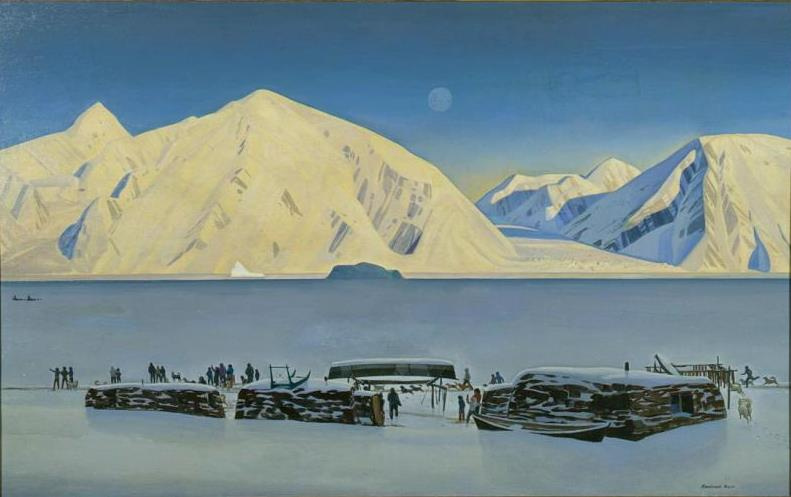log in
Enter site
Login to use Arthive functionality to the maximum
The Arrival of mail
Rockwell Kent • Painting, 1941, 101×163 cm
Description of the artwork «The Arrival of mail»
Rockwell Kent began to work on The Arrival of mail during his last trip to Greenland and finished it in the States, on the family Asgaard farm, which is located in the north-east of the New-York State near the Adirondack Mountains. This grand canvas can explain by itself why the Greenlandic series by Kent is considered to be a peak of his artistic revolution. Here, his ability to combine heroic epic landscapes with genre painting is brought to the shining perfection. The liveliness of natives meeting the long-awaited mail transport was skillfully highlighted with an ice-cold calmness of the magnificent nature. The pulse of life optimistically breaks through the permafrost. There is no doubt that this work required long and detailed work. Still, it’s difficult to believe that he could miss something with all his non-human energy and monstrous commitment. Probably, he finished painting at Asgaard in order to move back in time to Greenland again and again, by means of brushes and paints, as this place became a real home and motherland for him. Moreover, by that time, the things in the States were getting harder for the artist.
Kent, committed socialist and a tireless Don Quixote, had never missed a chance to climb up the barricades. If there weren't any barricades nearby, he built them himself. In the early 1930s, he started a loud legal battle with the railway company and, having lost a large part of his savings, only managed to become notorious troublemaker disturbing public peace. This heightened feeling of justice sometimes led to almost comic situations: in the morning, he could draw a Christmas Calendar for “General Electric” and at noon go on strike with the workers of the company with an irate banner in his hands. After returning from Greenland, Kent gave lectures in which he glorified “the simple life of plain people” and questioned American values. All this created an aura of unreliability around him.
In the 50s, during the McCarthy era, Kent's things took a lousy turn. Being one of the authors of the Stockholm Appeal, he would finally be declared "red". His books would be withdrawn from the libraries and paintings – from the galleries. Even his dairy farm would be on the verge of bankruptcy as the nation would stop buying his Communist cows’ milk.
This tragic turn in Rockwell Kent’s life would be a real success for the Soviet Union – the artist would donate 80 of his paintings and 800 drawings to Soviet museums.
Obviously, in the 30s Kent couldn't know how it would turn out. But he could feel that finishing his Greenland paintings, escaping to his favourite Greenland from political squabbles, money problems and debates about the progressiveness of abstract art.
For Kent himself, the arrival of mail was a disturbing subject. In winter, mail was not delivered to Northern Greenland, and the communication resumed only with the coming of spring. Rockwell would wait long months for letters from his wife Frances. Their marriage was going through difficult times, and there were no letters. However, Kent managed to leave his personal feelings "behind the scenes". There is not even a hint of disturbance in the picture, only hope, light and endless space. His Greenland is a place where life is simple, people are kind and friendly, and the mail arrival guarantees, if not good news, then at least the spring.
Author: Andrew Zimoglyadov
Kent, committed socialist and a tireless Don Quixote, had never missed a chance to climb up the barricades. If there weren't any barricades nearby, he built them himself. In the early 1930s, he started a loud legal battle with the railway company and, having lost a large part of his savings, only managed to become notorious troublemaker disturbing public peace. This heightened feeling of justice sometimes led to almost comic situations: in the morning, he could draw a Christmas Calendar for “General Electric” and at noon go on strike with the workers of the company with an irate banner in his hands. After returning from Greenland, Kent gave lectures in which he glorified “the simple life of plain people” and questioned American values. All this created an aura of unreliability around him.
In the 50s, during the McCarthy era, Kent's things took a lousy turn. Being one of the authors of the Stockholm Appeal, he would finally be declared "red". His books would be withdrawn from the libraries and paintings – from the galleries. Even his dairy farm would be on the verge of bankruptcy as the nation would stop buying his Communist cows’ milk.
This tragic turn in Rockwell Kent’s life would be a real success for the Soviet Union – the artist would donate 80 of his paintings and 800 drawings to Soviet museums.
Obviously, in the 30s Kent couldn't know how it would turn out. But he could feel that finishing his Greenland paintings, escaping to his favourite Greenland from political squabbles, money problems and debates about the progressiveness of abstract art.
For Kent himself, the arrival of mail was a disturbing subject. In winter, mail was not delivered to Northern Greenland, and the communication resumed only with the coming of spring. Rockwell would wait long months for letters from his wife Frances. Their marriage was going through difficult times, and there were no letters. However, Kent managed to leave his personal feelings "behind the scenes". There is not even a hint of disturbance in the picture, only hope, light and endless space. His Greenland is a place where life is simple, people are kind and friendly, and the mail arrival guarantees, if not good news, then at least the spring.
Author: Andrew Zimoglyadov


